その後、どうしても気になるネパールの豚肉事情をwebで渉猟してみました。
Helen M. Macbeth 編 (1997)
「Food Preference and Taste: Continuity and Change」
の一章に、
Christian McDonaugh 著
「Breaking The Rules Change in Food Acceptability among the Tharu of Nepal」
があり、その中で、
In Nepal in the past and still to some extent now, the situation is complex in that foods eaten by some middle-ranking groups were very varied and included buffalo, pork, yak and beef. All of these are in varying degrees low-status foods from the point of view of the high Brahman and Chetri hindu caste groups.
(中略)
Diet markers map on to this hierarchy in away fairly typical of the north India and of mainstream Hindu caste in Nepal. Broadly speaking the Brahmans are vegetarian, though lower ranking Brahmans do eat some meats such as pigeon and maybe goat. Chetri eat goat and chicken. Tharu eat all of the above plus pork which in terms of Brahmanic values of purity is a low-ranking impure food. The lowest castes eat buffalo as well as all the above, with only the Sarki eating beef.
Monika Mandal 著(2013)
「Social Inclusion of Ethnic Communities in Contemporary Nepal」
の中の記述には
The commoners linked to eat some kind of meat with the exception of cows anf female animals. Chickens were eaten by all castes except Brahmans and Chhetris. The Newars, the Tamangas, the Sherpas, the Sunwars and others took delight in taking buffalo meat, hens and pigs. Actually the Newars were great consumers of buffaloes, and also meat of goat, sheeps, ducks and fowls but they did not touch pigs.
(中略)
The Magars ate pork but not buffaloes’ flesh, while the Grungs ate the buffalo but not the pig. Most of the Brahmans were vegetarians.
Durga Datt Joshi 他著
「Improving meat inspection and control in resource-poor communities: the Nepal example」
Acta Tropica 87, 119-127 (2003)の中では
In Nepal, buffaloes contribute about 64% of the meat consumed, followed by goat meat (20%), pork (7%), poultry (6%) and mutton (2%). Goat and poultry meat is acceptable to all castes of people while buffalo meat is consumed mainly by the Newar ethnic group. Previously, pork was consumed only by people belonging to low castes, however, in recent years, the consumption of pork has increased in higher castes as the caste system has become more relaxed.
とあります。一番最近の文章ではPIG PROGRESS(Sep. 20, 2017)のPig farming in Nepal is growing step by stepの記事の中で、
At the moment, professional pig production in Nepal is still in its infancy. As the country is gradually becoming less traditional and more modern, different trends and eating habits are surfacing.
Nepal may not be top of mind when talking about pigs. Quite rightly so – the country doesn’t have an overly rich tradition when it comes to pork consumption. After all, Nepal may have a rich diversity of ethnic communities, castes and beliefs, traditionally however, only a limited number of them accepted pig farming. Pork is consumed by certain communities like e.g. the Rai, Sherpa and Tamang. So-called ‘upper caste’ communities, however, would never go anywhere near pork.
That picture, however, is slowly changing these days. Especially in urban communities and amongst the younger generations, the cultural food restrictions have lost their importance. Also, cities are growing fast due to ongoing migration, which altogether leads to a picture of a country that is gradually changing its eating habits.
と、書かれています。
日本人には窺い知れないカースト制度に伴う奥深い慣習がやはり有るようです。これらを念頭に、現役世代の方々に話を聞きました。彼らの親や祖父母の世代までは、ブラーマンBrahmanやチェトリChetriの人々にとっては、やはり豚は食べない、あるいは近寄ってもいけない動物だったようです。家庭によっては今もその慣習に従うそうです。一方で、上の記述の様に、彼らの世代や更に若い世代ではあまりそれに囚われない人もいるとの事です。
何方か、もっと詳しい事情をお知りの方、是非お教え下さい。
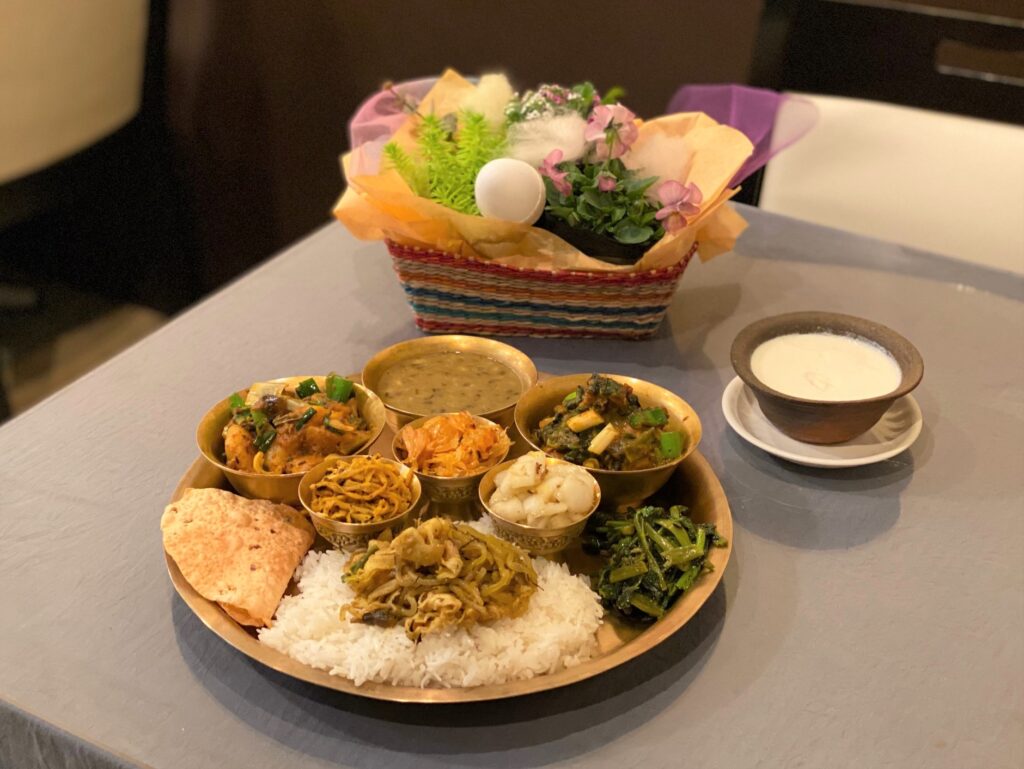
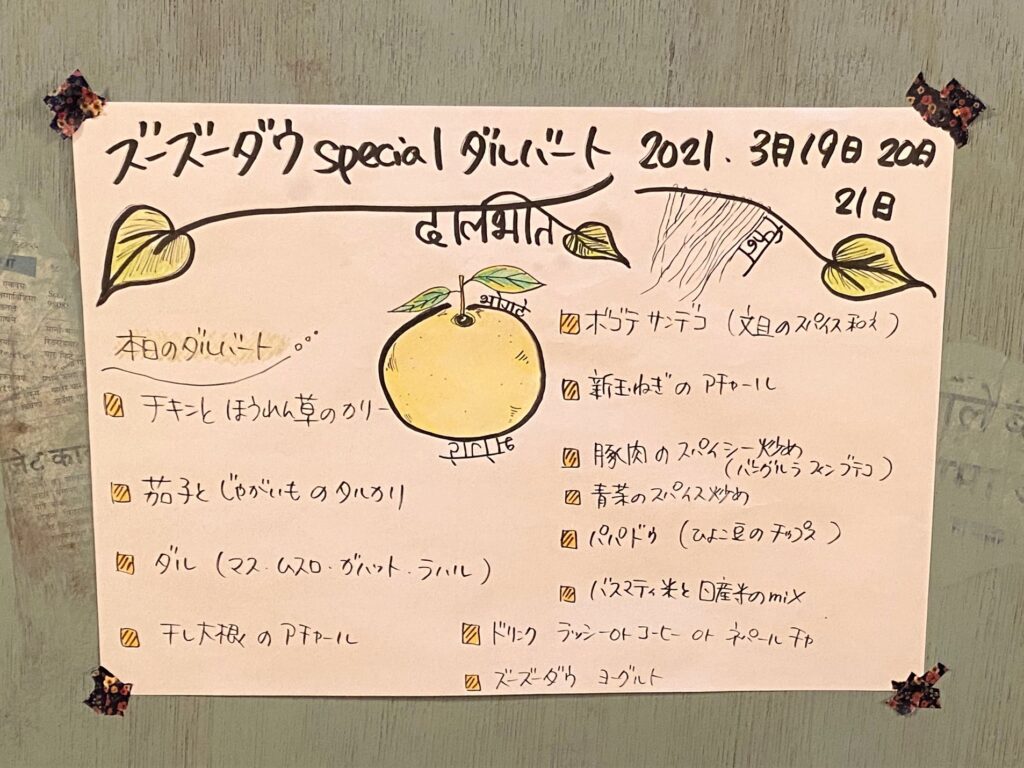 東ネパールでは食べられることの多い豚肉と、チベット族の料理ギャコックなどにも使われる澱粉麺のピン(フィン) Phing を組み合わせたスパイシー炒め Bangur ra Phing Bhuteko が初登場です。使われているのはさつま芋の澱粉から作ったネパール製の Phing とのことでした。
東ネパールでは食べられることの多い豚肉と、チベット族の料理ギャコックなどにも使われる澱粉麺のピン(フィン) Phing を組み合わせたスパイシー炒め Bangur ra Phing Bhuteko が初登場です。使われているのはさつま芋の澱粉から作ったネパール製の Phing とのことでした。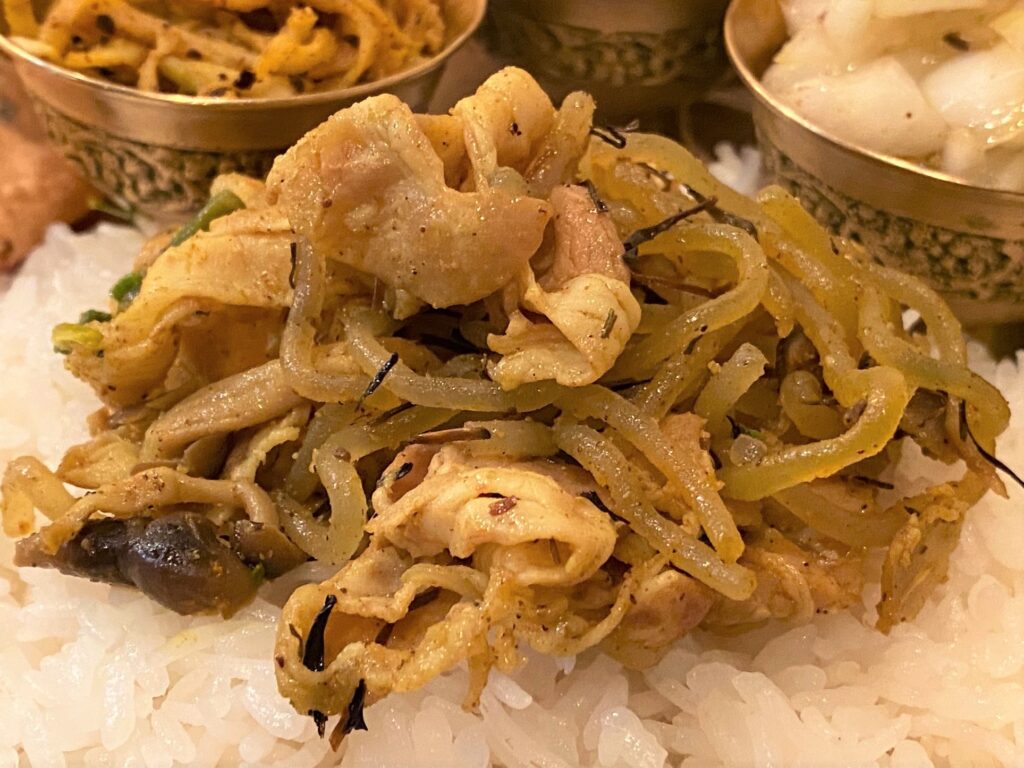 ダルは、マス、ムスロ、ラハル、ガハットのミックス、
ダルは、マス、ムスロ、ラハル、ガハットのミックス、 マスはチキンとほうれん草、
マスはチキンとほうれん草、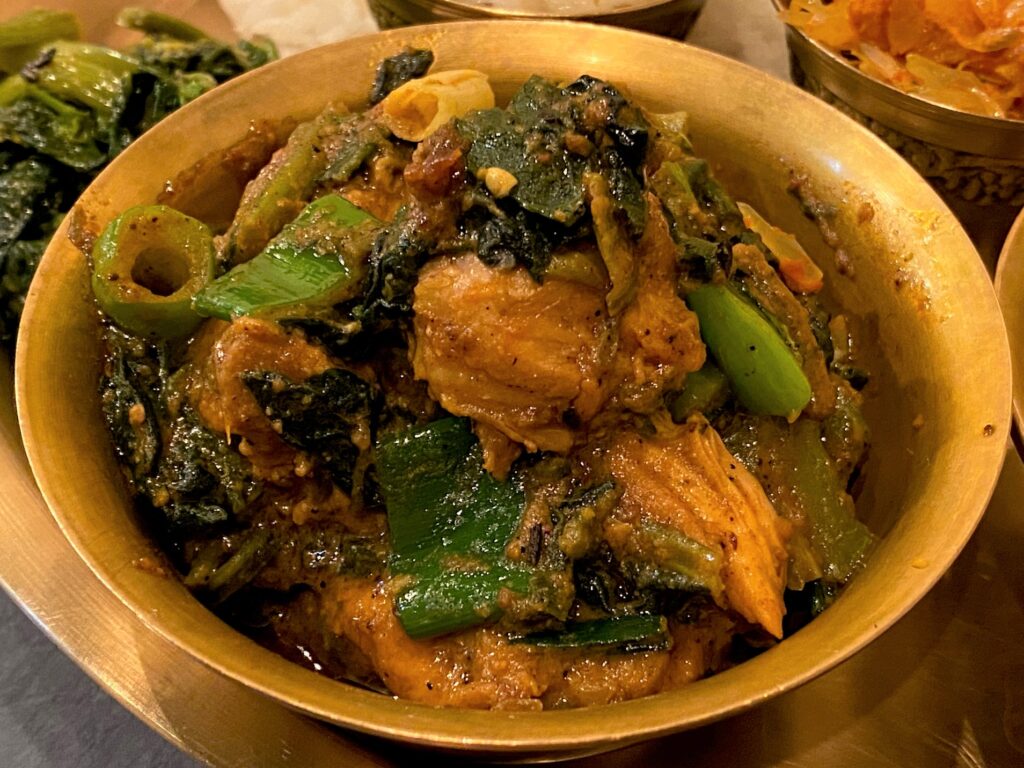 茄子とじゃが芋のタルカリに、
茄子とじゃが芋のタルカリに、 果物シリーズは文旦のスバイス和え Bhogate Sadeko、
果物シリーズは文旦のスバイス和え Bhogate Sadeko、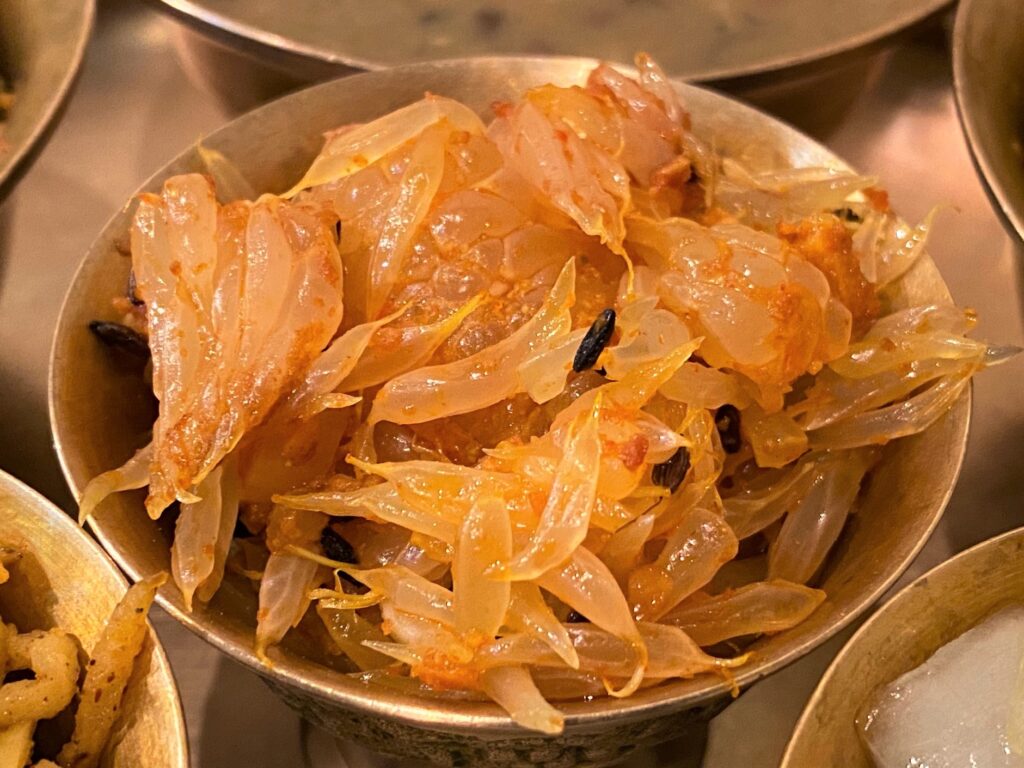 干し大根のアチャールと、
干し大根のアチャールと、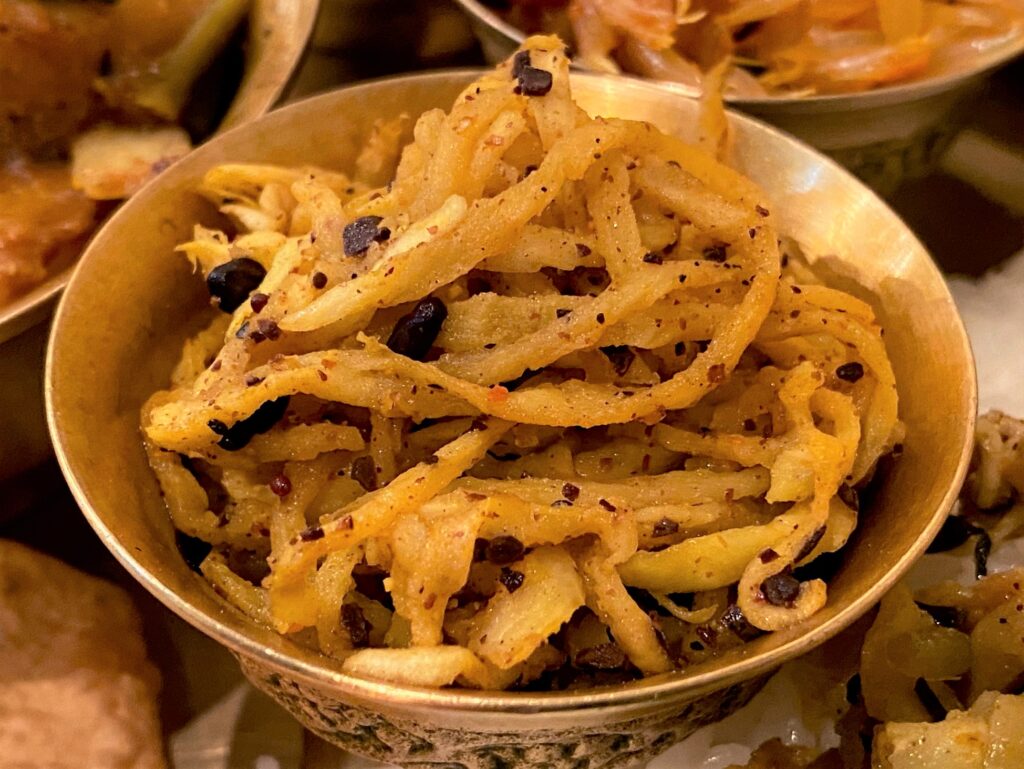 新玉葱のアチャール、
新玉葱のアチャール、 青菜炒めとパパドゥが並びました。食後はズーズーダゥとチヤを頂きました。
青菜炒めとパパドゥが並びました。食後はズーズーダゥとチヤを頂きました。
